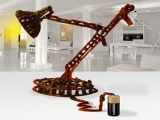So far, two 3D printing pens have been successfully launched, the 3Doodler and the smaller, more elegant Lix. Now, though, there is a third, one that could trounce both of them. It is called CreoPop.
Well, the company is called CreoPop, and the pen is named after it. The reason it is different from the other two is simple: the technology used to 3D print objects is different.
3Doodler and Lix both use fused deposition modeling (FDM), which consists of superheating a stick of plastic filament until it melts, allowing you to draw and “build” stuff from it.
The CreoPop folks wanted to remove the risk of superheated plastic scattering all over the place while you playfully fumble through a half-baked structure.
They also wanted to make their pen unreliant on constant replacement of the plastic sticks you always need to push into the 3Doodler's or Lix' back end.
How is this all achieved? Instead of FDM technology, the CreoPop pen uses stereolithography, or SLA 3D printing, for short.
In SLA, a resin or ink is exposed to light and, due to that exposure, hardens. The CreoPop 3D printing pen literally writes and draws in mid-air.
Provided you take the time to build your way up from a flat surface of course. As awesome as 3D printing technology is, defying gravity is still beyond it. And everything else humans have ever made really.
Normally, SLA printers have a rank where resin is held. The light emitters are mounted above and move about. As the printing process goes along, the structure effectively “grows” of out the viscous fluid below.
The CreoPop pen has a primary orifice through which the resin pours out when you press the button. At the same time, an ultraviolet laser is activated, and cures the resin, rendering it solid.
And you're not restricted to a single type of ink here. You can use magnetic ink to make items that can stick to the refrigerator, make things out of a heat-sensitive resin (changes colors due to temperature), elastic ink, body inks, even conductive inks (circuit drawings anyone?) and stuff that glows in the dark.
It's a shame that the CreoPop 3D Printing Pen isn't ready for commercialization yet. Indeed, the company hasn't gotten around to launching the Indiegogo crowd-funding campaign yet. Fortunately, the first version of the pen itself is finished and pretty refined. Below and above are some sample prints.

 14 DAY TRIAL //
14 DAY TRIAL // 



